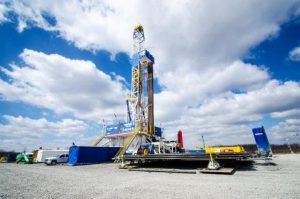
Chesapeake Energy reported its earnings for 2018 and the fourth quarter of the year were both slightly lower than a year earlier. While also reducing some of its debt by nearly $2 billion, the company reported 2018 net income available to shareholders totaled $775 million or 85 cents a share but the adjusted earnings were $816 million or 90 cents a diluted share.
The fourth quarter 2018 net income came to $486 million or 49 cents a share while the adjusted net income was $238 million or 21 cents a share.
The report followed Chesapeake’s more than $4 billion acquisition of WildHorse Energy in Texas which is now referred to as the company’s Brazos Valley business unit. The acquisition was part of Chesapeake’s move to focus more on oil production rather than the natural gas production it historically had followed for years.
“Our strategic focus on increasing our oil production is working, as we increased annual net oil volumes from the PRB by 78 percent in 2018, resulting in oil production representing 21 percent of our overall production mix in December.,” stated Doug Lawler, Chesapeake’s President and CEO. “Our oil focus will be fully evident in 2019, as annual net oil volumes from the PRB are expected to more than double compared to 2018 and as we begin a robust drilling program on our Brazos Valley asset, while also attacking the base production in all our operating areas with full-field optimization and downtime reduction programs. ”

The company financial report stated that the projected 2019 average daily oil production of 116,000 to 122,000 bbls was a 32 percent increase. It also projected its 2019 capital expenditures will range from $2.3 billion to $2.5 billion compared to the $2.366 billion in 2018.
“We are off to a fast start in 2019,” added Lawler. “With the integration of the Brazos Valley asset into Chesapeake fully underway, we are already seeing a significant amount of cost savings to be captured and strong performance from the asset.”
He also expects the company’s cash flow to be stronger in 2019.
Driven by the increase in oil volumes the company is projecting going forward, Chesapeake signed an oil gathering agreement during the 2018 fourth quarter that will deliver its oil volumes via pipelines into the Guernsey, Wyoming market at a substantially lower cost than the company was incurring by trucking volumes. This oil gathering system will also connect directly to interstate pipelines with available capacity to the Cushing, Oklahoma market and further to Gulf Coast premium markets, providing additional takeaway options to Chesapeake in the future as basin production grows.
In the company’s legacy Eagle Ford Shale position in south Texas, Chesapeake is currently utilizing four drilling rigs and expects to place on production up to 125 wells in 2019, compared to 157 wells in 2018.

The company’s Brazos Valley business unit will be focused on targeting both Eagle Ford and Austin Chalk wells in the large acreage position gained in the WildHorse acquisition. Chesapeake will operate four rigs in the Brazos Valley area in 2019 and expects to place on production up to 83 wells, including 10 wells targeting the Austin Chalk formation, with average completed lateral lengths of approximately 8,000 feet.
In the Marcellus Shale in northeast Pennsylvania, Chesapeake is currently utilizing three drilling rigs and expects to place on production up to 48 wells in 2019, compared to 54 wells in 2018.
In the company’s Haynesville Shale position in Louisiana, Chesapeake is currently utilizing two drilling rigs and intends to drop to one rig in the 2019 second quarter. The company expects to place on production up to 24 wells in 2019, compared to 26 wells in 2018.
In the company’s Mid-Continent operating area in Oklahoma, Chesapeake is currently utilizing one drilling rig.





